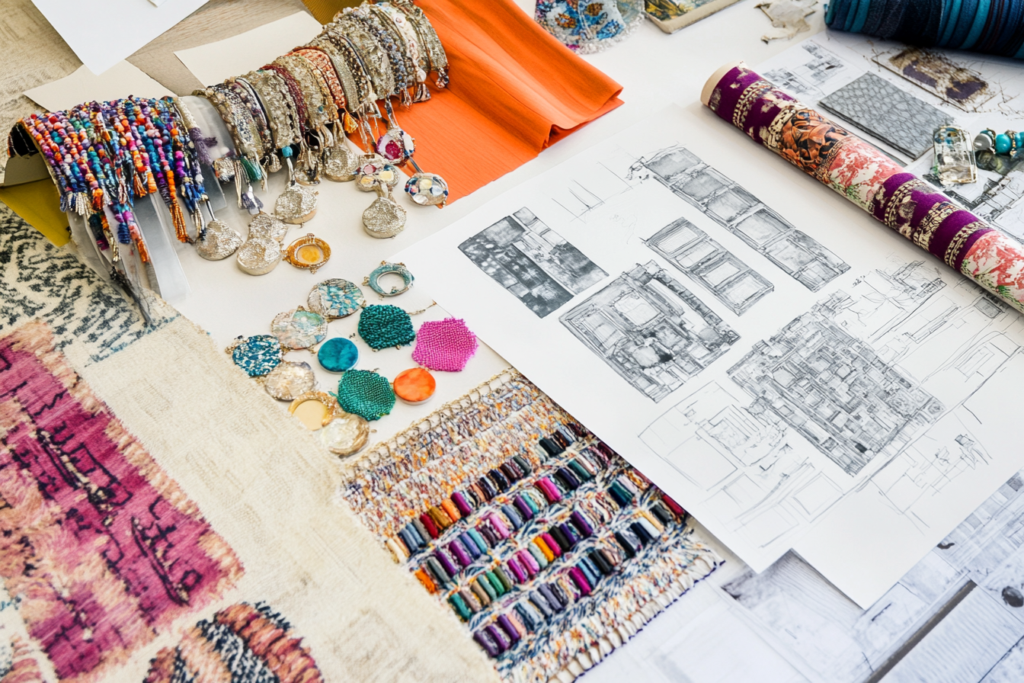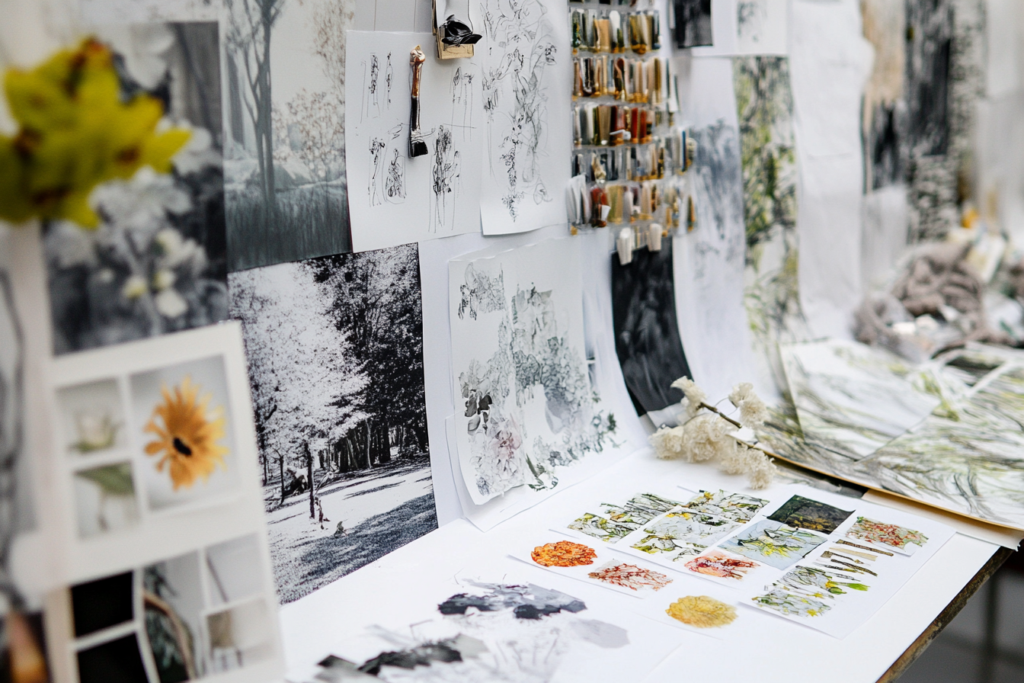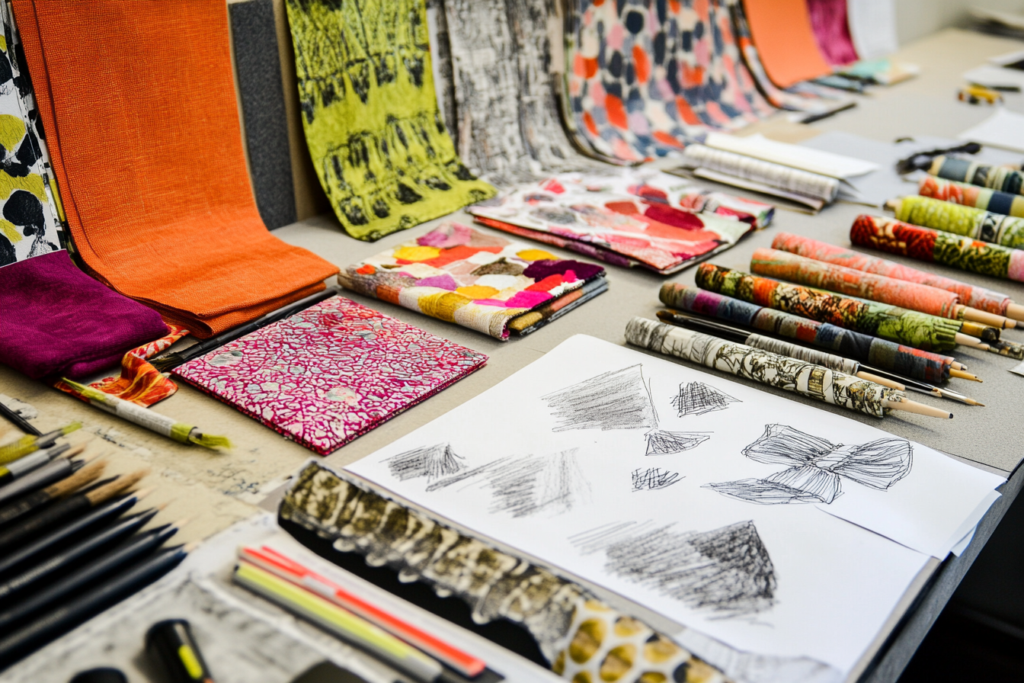Introduction: What is a Concept Board?
A concept board is an essential tool used in fashion design to visually communicate initial design ideas and inspirations. It serves as a presentation board containing various elements like sketches, color swatches, fabric samples, prints, and decorative details, all coming together to form a cohesive concept for a new collection or garment.
Often used at the beginning of the design process, concept boards allow designers to visually explore and share their vision with teams, clients, and stakeholders. This creative tool is crucial for conveying the look and feel of a design before it is brought to life in actual garments.


Components of a Concept Board
A typical concept board includes a range of visual elements that represent the designer’s vision for a collection. These elements work together to tell a story about the mood, style, and theme of the collection. Common components of a concept board include:
- Sketches and Illustrations:
- Hand-drawn sketches or digital illustrations of garments or designs give a clear representation of the proposed clothing. They might show the silhouette, details like collars or sleeves, and even how fabric drapes.
- Color Swatches:
- Color is a vital component in fashion, and color swatches on a concept board demonstrate the palette that will be used throughout the collection. These swatches can help set the tone for the entire design, whether the collection is bold, muted, or pastel.
- Fabric Swatches:
- Fabric samples are included to give a tactile sense of the materials that will be used in the designs. These swatches might feature various textures and weaves to represent the intended feel of the garments.
- Prints and Patterns:
- For collections with printed fabrics or patterns, concept boards will often include examples of these prints. Whether florals, stripes, or abstract designs, the prints provide insight into the aesthetic direction of the collection.
- Decorative Details:
- Details such as embroidery, embellishments, and other decorative elements are highlighted on the concept board. These details are often key in distinguishing a designer’s unique style and adding flair to the designs.
Why Are Concept Boards Important?
Concept boards serve as a visual reference point for designers and help bring their creative ideas to life in a tangible way. They are critical for several reasons:
- Clarifying Design Vision:
- By assembling various elements in one place, the designer can visually confirm whether their ideas align with the intended direction for the collection. It allows them to assess how different components like color, texture, and style work together.
- Communicating Ideas to Others:
- A well-constructed concept board is a powerful tool for presenting designs to clients, fashion teams, or stakeholders. It effectively conveys the designer’s inspiration and concepts, helping others understand the creative direction without needing detailed verbal explanations.
- Inspiration and Ideation:
- Often, a concept board is used early in the creative process as a form of brainstorming. It allows designers to experiment with different themes, colors, fabrics, and styles before settling on a final collection.
- Establishing the Mood and Theme:
- A concept board sets the tone for the collection. Whether the theme is avant-garde, minimalistic, or romantic, the visuals on the concept board establish the mood and aesthetic that the designer aims to achieve.
How to Create a Concept Board
Creating an effective concept board requires a combination of creativity, organization, and communication. Here are a few tips for designers looking to build a strong concept board:
- Start with a Theme:
- Choose a central theme or inspiration that will guide the rest of your design process. This could be anything from a historical period, a specific culture, or even a particular color or texture. The theme will influence all other elements on the board.
- Collect Inspiration:
- Gather images, fabric swatches, color palettes, and other materials that speak to your theme. Be open to all kinds of inspiration—from nature and art to fashion icons or photography.
- Arrange and Layer the Elements:
- Once you have your materials, begin arranging them on the board in a way that feels cohesive. Experiment with the placement of colors, fabrics, and sketches until the board feels balanced and reflective of your vision.
- Focus on Key Details:
- Include only the most essential elements that represent the essence of your collection. Too much information can make the concept board feel cluttered, so focus on what best communicates your ideas.
- Keep It Professional:
- Since the concept board is often presented to clients or teams, it should look polished and professional. Use high-quality materials, and ensure the layout is neat and organized to present a strong first impression.
Examples of Concept Board Uses in Fashion Design
- Pre-Collection Concept Boards:
- Before a new collection is created, designers will present concept boards to their teams or investors. These boards might focus on the key colors, materials, and designs that will be featured in the collection.
- Trend Forecasting:
- For trend forecasting, designers or companies may create concept boards that reflect the predicted styles, colors, and fabrics that will dominate the upcoming season. These boards can serve as blueprints for future collections.
- Branding and Marketing:
- Concept boards can also be used to communicate a brand’s identity, highlighting core colors, patterns, and silhouettes that represent the brand’s aesthetic. These boards help align the design team and marketing professionals on the visual identity of the brand.
Conclusion: The Creative Power of Concept Boards
A concept board is more than just a collection of sketches and fabric swatches. It is a powerful creative tool that allows fashion designers to visually communicate their ideas, set the tone for a collection, and inspire their teams. Whether for initial ideation or presenting ideas to clients, a concept board provides a solid foundation upon which the entire design process can be built.



